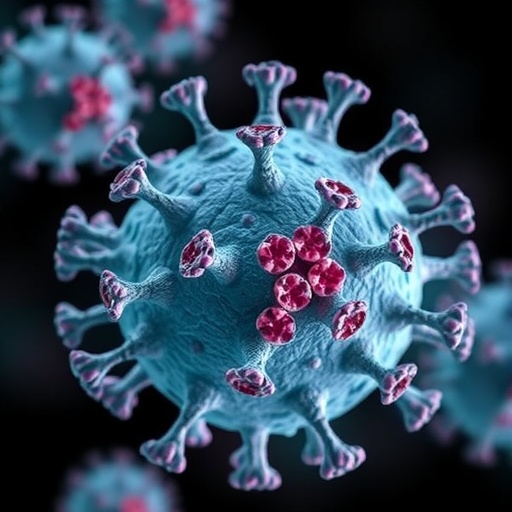Recent research has shed light on the enigmatic relationship between viral infections and autoimmune disorders, with a groundbreaking study exploring this connection in the context of Sjögren’s disease (SjD). Sjögren’s disease is a chronic autoimmune condition characterized primarily by lymphocytic infiltration of exocrine glands, leading to dry mouth and dry eyes, but its precise etiological drivers remain elusive. The study, conducted by Zhang et al., elucidates a novel virome signature in the saliva of patients with SjD and uncovers a compelling mechanistic link implicating a viral agent in triggering pathogenic autoimmunity.
Using advanced shotgun metagenomic sequencing techniques, the research team analyzed the salivary virome profiles of 35 patients diagnosed with SjD alongside 25 healthy control subjects. This approach allowed for comprehensive characterization of viral communities present within the oral cavity, far beyond what targeted viral PCR or culture methods can achieve. The metagenomic data revealed a pronounced expansion of bacteriophages belonging to the Siphoviridae family in SjD patients, particularly in those exhibiting heightened disease activity, suggesting that microbial viral populations could play a role in immune dysregulation.
More notably, sequences attributed to eukaryotic viruses were markedly enriched in the SjD cohort. Among these, a relatively obscure virus named Vientovirus emerged as a prominent feature associated with impaired lacrimal gland function—a clinical hallmark of SjD—and elevated titers of anti-SSA/Ro52 autoantibodies. Anti-SSA/Ro52 is one of the principal immunological markers used in diagnosing SjD and is implicated in mediating tissue damage in this disease. The discovery of Vientovirus’s association with these disease metrics prompted further in-depth molecular investigations.
Through comprehensive alignment analyses, the authors identified striking sequence homology between the capsid protein of Vientovirus and the autoantigen SSA/Ro52. This observation suggested the phenomenon of molecular mimicry, wherein a foreign antigen shares structural and sequence features with host proteins, potentially inciting autoreactive immune responses. To confirm the functional relevance of this mimicry, the researchers employed cross-blocking assays, demonstrating that antibodies targeting the viral capsid protein could cross-react with the SSA/Ro52 autoantigen. This cross-reactivity provides tangible mechanistic evidence that Vientovirus infection might precipitate aberrant immune activation seen in SjD.
To test causality, the study extended into in vivo models by immunizing mice with a peptide derived from the Vientovirus capsid protein. Remarkably, these mice developed autoantibodies against SSA/Ro52 akin to those found in patients with SjD, and exhibited immunopathological features resembling the human disease. This experimental validation underscores the sufficiency of the viral capsid antigen in breaking self-tolerance and initiating pathological autoimmunity, thereby linking viral exposure directly to disease causation.
These findings carry profound implications for understanding autoimmune pathology. The identification of distinct virome alterations, specifically the predilection for Siphoviridae bacteriophages and eukaryotic viral agents like Vientovirus, suggests that the oral virome contributes to the immunological milieu that favors autoimmunity. The viral mimicry of autoantigens elucidates one molecular pathway through which environmental factors might instigate or exacerbate genetically predisposed autoimmune disease states.
The study’s integration of multi-dimensional analyses—from metagenomic sequencing to structural protein alignment and animal modeling—demonstrates a paradigm for dissecting complex host-microbe interactions. Prior hypotheses have long proposed viral triggers in autoimmune diseases, yet direct mechanistic evidence in humans has been scant. This research decisively bridges that gap for Sjögren’s disease by attributing a defined viral antigen to the initiation of autoantibody production and glandular dysfunction.
Moreover, these discoveries could pave the way for innovative therapeutic strategies. Targeting viral reservoirs, modulating phage populations in the oral microbiome, or developing vaccines or immunotherapies aimed at blocking viral mimicry epitopes might halt or mitigate disease progression. Given that current treatments mostly address symptoms without altering underlying pathogenesis, insights into the virome’s contributory role hold promise for disease-modifying interventions.
The implications extend into diagnostic realms as well. Salivary virome profiling may evolve into a non-invasive biomarker approach to identify patients at risk for developing Sjögren’s disease or to stratify disease activity. Particularly, detection of Vientovirus sequences or elevated anti-Vientovirus capsid antibodies could serve as early indicators of pathogenic immune processes before clinical deterioration ensues.
Finally, this research enriches the broader narrative linking the human microbiome and virome to autoimmune disorders. The oral cavity, often underappreciated as an immunologically active site, emerges here as a reservoir of viral elements capable of modulating systemic immune responses. The interplay between bacteriophages and eukaryotic viruses offers a sophisticated ecological context that might influence autoimmunity beyond classical genetic and environmental factors.
In conclusion, Zhang and colleagues’ work delineates a compelling viral connection in Sjögren’s disease pathogenesis, highlighting Vientovirus capsid protein’s molecular mimicry of SSA/Ro52 autoantigens as a key driver of autoimmunity. Their comprehensive approach substantiates the viral trigger hypothesis, offering new vistas in understanding, diagnosing, and treating this enigmatic autoimmune syndrome.
Subject of Research:
The study investigates the role of the salivary virome, particularly Vientovirus and bacteriophages, in the pathogenesis of Sjögren’s disease through molecular mimicry and autoantibody induction.
Article Title:
Vientovirus capsid protein mimics autoantigens and contributes to autoimmunity in Sjögren’s disease.
Article References:
Zhang, X., Li, Y., Qin, Y. et al. Vientovirus capsid protein mimics autoantigens and contributes to autoimmunity in Sjögren’s disease. Nat Microbiol (2025). https://doi.org/10.1038/s41564-025-02115-3
Image Credits:
AI Generated
Tags: bacteriophages in autoimmune diseaseschronic autoimmune conditionsimmune dysregulation in Sjögren’s diseaselymphocytic infiltration in exocrine glandsmetagenomic sequencing in SjDpathogenic mechanisms in Sjögren’s diseasesalivary virome profilesSjögren’s disease researchVientovirus and autoimmunityviral agents triggering SjDviral infections and autoimmune disordersviral mimicry and autoantigens





